We independently evaluate all recommended products and services. Any products or services put forward appear in no particular order. If you click on links we provide, we may receive compensation.
The Kershaw Atmos is the Porsche 912E of pocket knives. Wow, you think! I can get a Porsche for $30! Let me go buy one now!
Well, understanding the importance of this metaphor depends on how well you know your old Porsches. The 912E was an unusual vehicle for Porsche, made for one year only – 1976. It was intended as a temporary offering at the bottom of Porsche’s lineup, bridging the gap between the discontinued 914 and the upcoming 924 as the brand’s 4-cylinder option. They used the body of the renowned 911 sports car, but fitted it with a Volkswagen “Type 4” engine which produced 86 horsepower compared to the 150 or 175 of a standard 911 at the time. So it looked exotic but it was actually just a slow, overpriced Beetle.

Key Specs: Kershaw Atmos
In the past 10 years Kershaw has put out some really disappointing budget knives – far cries from the fantastic era that brought us all-star products like the Leek, Blur, Skyline, Mini Cyclone, Junkyard Dog, Tilt, and myriad other ground-breaking designs. They’ve been universally forgettable, with cheap steel, heavy handles, and anonymous designs that are here one year and gone the next. But perhaps this Atmos – and some other new products Kershaw’s brought out in 2018 – are a sign of a budget resurgence at the brand that once dominated this market so hard no one even bothered to compete.

Perhaps they realized that brands like Tangram, Ruike, Steel Will, ESEE, Ontario, etc were beginning to really steal their thunder. Who knows, but with the Atmos we’ve got a knife that’s both cheap and genuinely likable in a lot of ways to knife enthusiasts, which isn’t something that could be said of any budget Kershaw in years. After all, there are devoted fans of the Porsche 912. Let’s dive in.
The Blade
Okay, you’ve got to arrive at a $30 retail price somehow. The Atmos uses 8Cr13MoV steel, but – hey, don’t skip ahead yet. Sort of like if you started with a 912E and then fitted every hot-rod part to it from the aftermarket, Kershaw has made the most of it.
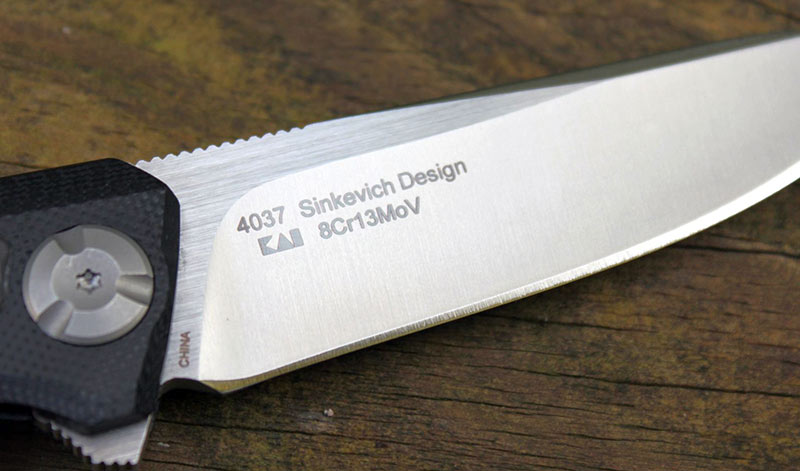
The blade comes in at 3” of length, cut from thin 0.10” stock. It’s got a clean satin finish with vertical grind lines on the primary bevel and horizontal grind lines on the flats, always a nice touch – and it’s got a pronounced high hollow grind. Blade shape is a traditional drop point with a long false swedge on the spine, the epitome of practicality. If you’re going to make a lightweight EDC folder, you should make it able to cut, and the geometry of this blade is perfect for it. It does suffer from a pronounced sharpening “beard” at the termination of the edge ahead of the plunge line. It came with a decent edge on it from the factory, capable of cutting printer paper going down the long side smoothly.
8Cr13MoV isn’t some magic super steel, but it’s not the worst thing on the market. Damning with faint praise, certainly, but many people compare it to AUS-8, and if AUS-8 is good enough for Al Mar it should be good enough for us, right? That’s a bit of convoluted logic, but chemically it’s similar – it’s got a bit more carbon (primarily responsible for edge retention and hardness), the same amount of chromium (corrosion resistance and hardness), and similar inclusions of other trace elements like molybdenum, silicon and vanadium.

It won’t perform as well as some old school steels like 440C, 154CM and VG-10, but it’s stainless and easy to sharpen and not especially prone to breaking or chipping due to the low HRc this steel normally runs at – 56-58 on the Rockwell scale. Compared to a more modern performance steel, it’s got half the carbon content of CPM S30V, and only a fraction of the molybdenum and vanadium, both of which are big contributors to strength and edge retention.
Deployment and Lockup
I can divide this section in two parts: before and after I sent it in for warranty repairs. When this knife arrived, brand new out of the box, it had no detent. It didn’t flip at all, except with a heavy wrist flick, which I thought was weird considering this knife uses a ball bearing pivot. Curiosity got the best of me and I disassembled the knife to see what was going on –maybe there was gunk built up in the detent hole on the blade? On the contrary, it appeared as though there was no detent – like it had been hit with a grinding wheel and was partially ground off. I haven’t the faintest idea how this occurred and no amount of fiddling and tweaking could make it work, so I sent it back to Kershaw to be repaired under warranty.
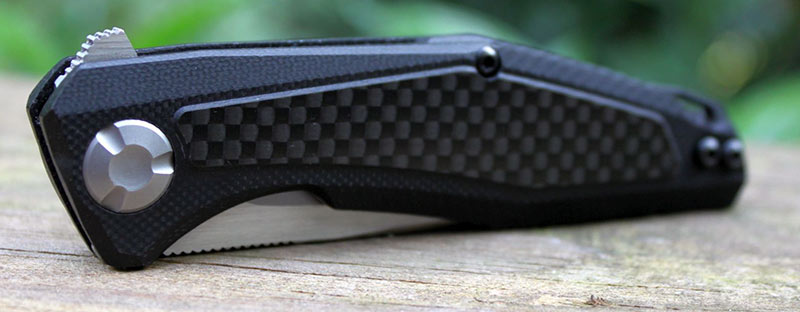
A few weeks later the knife arrived with a new locking liner, and I gotta say, it flips flippin’ great. There’s nothing especially fancy about this by modern standards – it uses steel bearings in plastic cartridges to keep costs down, but it’s plenty smooth. The light weight of the blade means that the detent doesn’t have to be overly hard for it to flip well. Because of the linerless construction, the Atmos uses a set of thin stainless washers in between the outside of the bearings and the inside of the handles to prevent wear, so just a dab of oil on both sides has this knife popping out smoothly.
The flipper tab is well shaped here, a triangle with the top of it lopped off at an angle with jimping along the front and top sides for traction. It’s more of a “lightswitch” style flipper. I suppose it’s not a shock but the action on this is much better than the Steel Will Cutjack Mini (which uses phosphor bronze washers) and also slightly better than the Tangram Orion (which also uses bearings) owing to its lighter blade and stronger detent.

Lockup on my repaired example is great – it uses a thin stainless liner lock which engages at about 50% and doesn’t exhibit any blade play vertically or horizontally. I’m beginning to think that liner locks are the way to go versus frame locks, as I’ve had less issue with $30-$50 liner locks than I have had with $200 titanium frame locks at this point. Some people who’ve left reviews on this knife on Amazon and BladeHQ have mentioned issues with lock stick due to the painted lockbar but I haven’t experienced this issue; your mileage may vary.
Features, Fit & Finish
Here’s where the Atmos stumbles a bit compared to other competition – Kershaw just hasn’t figured out how to make a $30 knife not feel like $30 as well as its competition has. There isn’t really anything functionally wrong with the Atmos, it’s just that it feels cheap in some areas. The linerless G10 handles with an integrated layer of carbon fiber certainly look good, but give them a firm squeeze and they flex visibly. Of course, so does the Manix 2 Lightweight and the Benchmade Bugout and no one is throwing those away in disgust. The carbon fiber is actually part of the molded G10 scales, but it still sort of feels stuck on- it’s not really a cohesive or necessary part of the design.
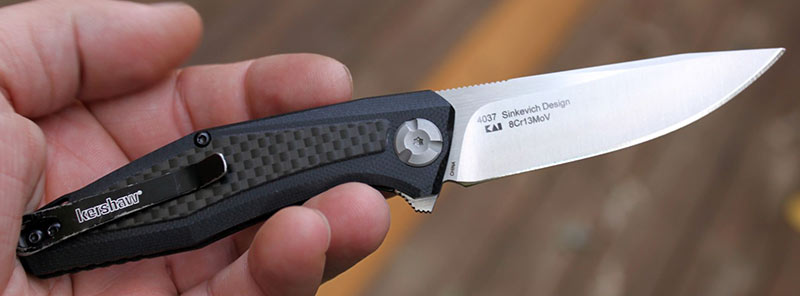
The pocket clip is painted and the paint scratches off easily, and despite wrenching the two mounting screws down as tight as they’ll go the clip still had some side-to-side “wiggle” at the end which you can feel when you’re using it. The fit of the detent ball into its hole is somewhat loose, and you can move the blade up and down in the closed position more than normal – sometimes referred to as ‘detent rock’. Blade centering favors the lock side when tightened down, although it doesn’t scrape the liner so it’s not a functional issue.
Oddly, the sharpened edge terminates well ahead of the plunge line, so there’s a big “beard” in front of the choil which makes sharpening annoying. And purely as a matter of opinion, the decorative pivots look and feel a little cheesy. It is a little heavy on labeling as Kershaws tend to be, with “Kershaw” on the show side and “4037 Sinkevich Design” and below that the KAI logo and blade steel, along with “China” stamped on the ricasso. And of course, as mentioned earlier the action was just non-existent when I first received it, although it was corrected by warranty.
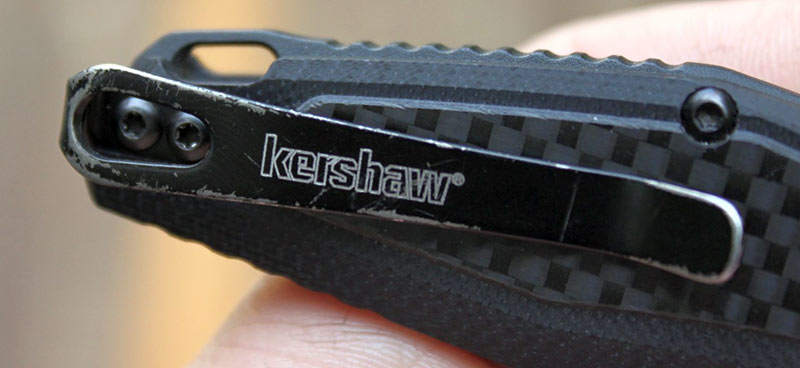
Of course it’s not all doom and gloom when it comes to features. Yes, that clip moves around – but what a great clip it is. A true deep carry clip, basically none of the blade is visible in your pocket when it’s clipped on. It’s configured for ambidextrous tip up carry and has a “blanking plate” screwed in place on the unused side, a nice touch. It’s easy to slide in and out of pockets but it still has enough spring tension to hold itself in place quite well. The backspacer is also neat, a molded plastic piece with some raised “gear” texturing and incorporating an oval lanyard hole that lines up with a cutaway in the handles.
It’s also nice that Kershaw did the carbon fiber inlay on both sides, which is sometimes skipped. I like the blade finish, too: in addition to the slicey hollow grind, the Atmos has a nice satin finish with crisp vertical grind lines on the primary bevel and perpendicular horizontal grind lines on the flats. It looks great when it reflects light. The handles have a few nice details as well, most notably a sculpted cutout on the show side that makes it easier to access the lock bar. One neat detail is how the very end of the spine lines up with the forward flat portion of the handle when closed, and how the spine of the blade lines up with the overall profile of the handle without protruding – some care was given to this design in the closed and open positions.
Field Test
I ended up carrying and using the Atmos way more than I expected to, especially considering the much nicer knives that float around my collection. I think that’s because it carries so well. When closed it has a very slim profile, and it only weighs in at 2 ounces – very light for a 3” blade knife, and aided by the aforementioned deep carry pocket clip, the Atmos really just disappears in your pocket.
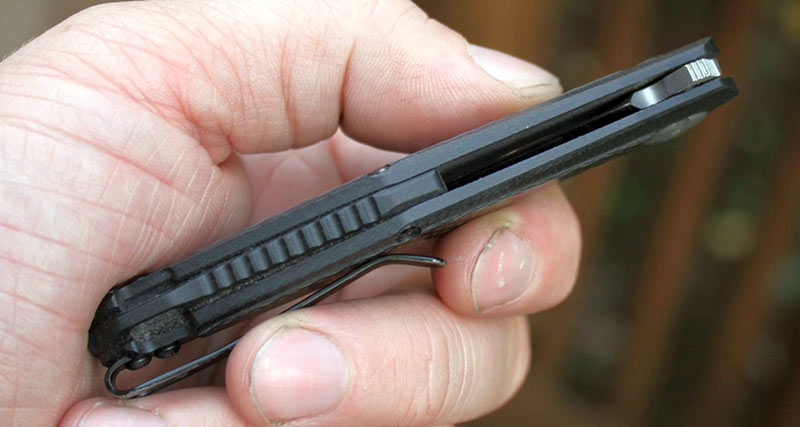
It fulfills the role of “adult fidget spinner” quite well, too. I realize in practical terms this isn’t terribly important (if we’re being honest) but this knife is very fun to flick, with a slick action, a satisfying detent and a smooth close. No one will mistake it for a Shirogorov, but it’s not a thousand dollars either.
Where it really excels over some of its other budget competitors is how it cuts. Kershaw wisely stuck with thin blade stock here (0.10”) and a deep hollow grind which is rare at this price point, and the Atmos just slides through thick plastic packaging and cardboard. The pronounced beard and choil sometimes causes material to drop in and hang the blade up, which is irritating, but otherwise the Atmos is an excellent cutter, better than some of the thicker knives around this price range like the Tangrams and the Ruike P801. The deep carry clip sits low enough to avoid being a hotspot in the hand, and it has jimping in the only place you actually need it: on the spine in front of the pivot for your thumb. There’s no forward choil, but it doesn’t exactly fit with the slim and sleek design ethos here anyway.

Being 8Cr13MoV, you’ll have to resharpen it more often than other competitors that use nicer steels – most notably Tangram’s Acuto, which is an upgraded version of 440C. This is a chorus we – and the whole knife community – have been singing for a while: you don’t have to burden a cheap knife with this steel. I get it, it’s cheap and it’s stainless and it’s local to the OEM so you’re not shipping heavy bar stock halfway across the world, but 8Cr is still something of a bummer. It is easy to sharpen, of course. These used to be the tradeoffs you had to expect with a $30 knife, but other manufacturers within spitting distance of this price point are using better steels. Maybe it’s time Kershaw did too.
Alternatives
All these knives available at BladeHQ.
If you really like the Atmos (with its $32 retail price) but wish it was nicer in every imaginable way, the Zero Tolerance 0470 (BladeHQ) is what you want. It’s the Lexus to the Atmos’ Toyota. Basically the same shape, the 0470 is the premium re-imagining of the Atmos is the same way that the Natrix/Bareknuckle is related to the 0770 and 0777, and the ZT 0393 is (sort of) the fancy Decimus, or the productionized Hinderer Maximus. It has marbled carbon fiber inlays, high end CPM 20CV steel, a titanium framelock with stabilizer, and a $240 price tag. So one of these, or 8 Atmos.
Curiously, if you sort BladeHQ’s listings by “folding knives, 3”-3.5”, under $100, flipper opening” their most popular model that fits this criteria is another Sinkevich designed Kershaw production collaboration, the Concierge (BladeHQ). It’s a bit bigger – 3.25” blade, 7.25” overall – and over twice the weight, at 4.3 ounces. It also has a hollow ground 8Cr13MoV blade and a KVT bearing pivot, but includes Sinkevich’s unique inset pocket clip that eliminates hot spots when you’re using it, and smooth G10 handles. It seems like a good deal at $38.

Another interesting knife at this price range is the CRKT (Columbia River Knife & Tool) Caligo (BladeHQ), designed by TJ Schwarz who also penned the slick Koenig Arius folder. It won “Best Buy of the Year” at Blade Show 2018, and it can be yours for $31. It features aluminum handles, a snappy IKBS bearing pivot, and a black-coated 8Cr13MoV blade. There’s also a deep carry pocket clip and a decorative blue pivot collar. It’s a similar size to the Atmos with a 3.1” blade and 7.6” overall length, but a bit heavier at 3.3 ounces.

If you’re willing to trade a ball bearing pivot for a better steel, the Steel Will Mini Intrigue is your knife. It has grippy textured FRN handles with nested stainless liners, a 3.25” hollow ground drop point blade in D2 steel, and flips very well despite being “handicapped” with phosphor bronze washers. It’s slim like the Atmos, and light too: despite the full stainless liners it’s only 2.2 ounces. At $38 it’s a no-brainer, like its chunkier brother the Mini Cutjack, which I must reiterate I loved when I tested it.
Finally, there’s the current champion of budget knives, the hard to pronounce but easy to love Ruike P801. It’s a stout stainless steel framelock with a 3.5” full flat ground drop point blade, made from Swedish Sandvik 14c28n steel. A ball bearing pivot and a flipper combined with this excellent steel are shocking at the $30 price point, and while it’s a little heavy at 4.3 ounces it’s still an excellent choice for the money.
Wrap-Up
When the Atmos first arrived at my door, it was an immediate flop. The non-existent detent made the knife a total bummer, and gave the pivot a gritty feel as well. I sent it back to Kershaw and waited a few weeks, (which cost a total of $7 for shipping, no charge for repairs) and the knife that arrived back was much better. It’s still not a great knife in terms of fit and finish or perceived quality in a lot of ways, but in terms of looks and function it’s great.

I don’t like the carbon fiber inlays, the wiggly clip, the off center blade, the detent rock, the cheesy pivot and all the branding, the blade steel and the beard on the edge. But this knife carries extremely well, cuts beautifully, and is fun to play with. These used to be the expectations at this price point, but today the market has moved on from accepting so many compromises.
I do like that Kershaw is showing signs of life in responding to what knife enthusiasts actually want – that is to say, we are all pretty tired of SpeedSafe and heavy knives – this is so much better of a knife than say, the Kershaw Cryo, which I have mixed feelings for lately. And you’d be a fool to count them out of this market entirely. This is a knife that with a better steel and a few quality improvements could be absolutely top of class, but even as is you’ll probably really enjoy it. And with any knife that’s $30, your risk of buyer’s remorse is low.
- Great flipper, thin blade stock and hollow grind makes it an excellent cutting tool, super light and slim with a deep carry clip makes it a superb carry, very pretty
- Arrived with the detent ground off and grit in the pivot, fit and finish issues, wiggly pocket clip, 8Cr13MoV steel
Kershaw Atmos
Quality/Performance - 77%
Value for Money - 70%
74%
Sinkevich design excellence at bargain basement price.
Disclaimer: the manufacturer sent us this review sample free of charge to evaluate. This has not affected our judgement on its quality or design, and we have not been paid for our opinion.





